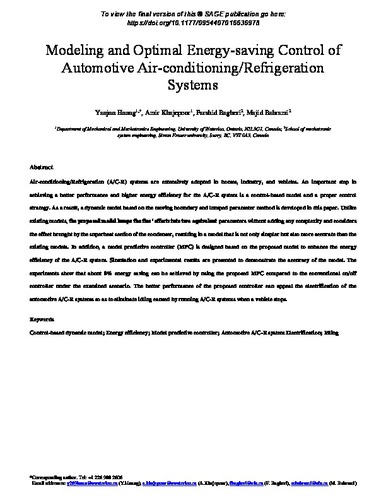| dc.contributor.author | Huang, Yanjun | |
| dc.contributor.author | Khajepour, Amir | |
| dc.contributor.author | Bagheri, Farshid | |
| dc.contributor.author | Bahrami, Majid | |
| dc.contributor.author | Bagheri | |
| dc.date.accessioned | 2017-03-30 18:55:37 (GMT) | |
| dc.date.available | 2017-03-30 18:55:37 (GMT) | |
| dc.date.issued | 2017-02-01 | |
| dc.identifier.uri | https://doi.org/10.1177/0954407016636978 | |
| dc.identifier.uri | http://hdl.handle.net/10012/11617 | |
| dc.description | To view the final version of this © SAGE publication go here: https://doi.org/10.1177/0954407016636978 | en |
| dc.description.abstract | Air-conditioning and refrigeration systems are extensively adopted in homes, industry and vehicles. An important step in achieving a better performance and a higher energy efficiency for air-conditioning and refrigeration systems is a control-based model and a suitable control strategy. As a result, a dynamic model based on the moving-boundary and lumped-parameter method is developed in this paper. Unlike existing models, the proposed model lumps the effects of the fins into two equivalent parameters without adding any complexity and considers the effect produced by the superheated section of the condenser, resulting in a model that is not only simpler but also more accurate than the existing models. In addition, a model predictive controller is designed on the basis of the proposed model to enhance the energy efficiency of the air-conditioning and refrigeration systems. Simulations and experimental results are presented to demonstrate the accuracy of the model. The experiments show that an energy saving of about 8% can be achieved by using the proposed model predictive controller compared with the conventional on–off controller under the examined scenario. The better performance of the proposed controller requires electrification of the automotive air-conditioning and refrigeration systems so as to eliminate the idling caused by running the air-conditioning and refrigeration systems when a vehicle stops. | en |
| dc.description.sponsorship | Automotive Partnership Canada (APC) || Cool-it Group | en |
| dc.language.iso | en | en |
| dc.publisher | Sage | en |
| dc.subject | Control-based dynamic model | en |
| dc.subject | Energy efficiency | en |
| dc.subject | Model predictive controller | en |
| dc.subject | Automotive A/C-R system electrification | en |
| dc.subject | Idling | en |
| dc.title | Modelling and optimal energy-saving control of automotive air-conditioning and refrigeration systems | en |
| dc.type | Article | en |
| dcterms.bibliographicCitation | Huang, Y., Khajepour, A., Bagheri, F., & Bahrami, M. (2017). Modelling and optimal energy-saving control of automotive air-conditioning and refrigeration systems. Proceedings of the Institution of Mechanical Engineers, Part D: Journal of Automobile Engineering, 231(3), 291–309. https://doi.org/10.1177/0954407016636978 | en |
| uws.contributor.affiliation1 | Faculty of Engineering | en |
| uws.contributor.affiliation2 | Mechanical and Mechatronics Engineering | en |
| uws.typeOfResource | Text | en |
| uws.peerReviewStatus | Reviewed | en |
| uws.scholarLevel | Faculty | en |

